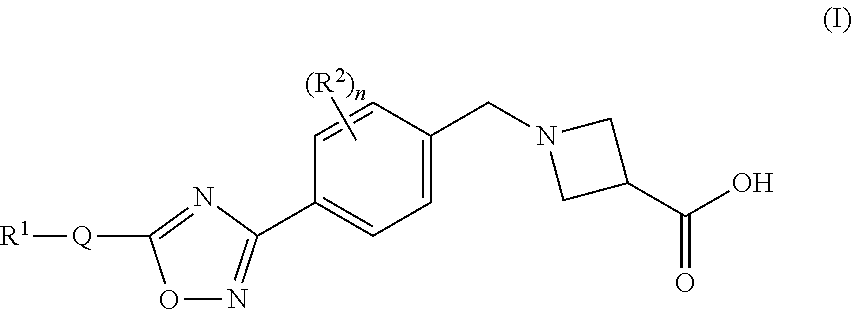Substituted isoxazole compounds
a technology of isoxazole and compound, which is applied in the field of substituting isoxazole compounds, can solve the problems of inconvenient use, inconvenient use, and inability to meet the needs of patients, and achieves the effects of reducing the risk of inconvenient use, and improving the effect of lipid metabolism
- Summary
- Abstract
- Description
- Claims
- Application Information
AI Technical Summary
Benefits of technology
Problems solved by technology
Method used
Image
Examples
example 1
1-(4-(5-(3-Phenyl-4-(trifluoromethyl)isoxazol-5-yl)-1,2,4-oxadiazol-3-yl)benzyl)azetidine-3-carboxylic acid
[0325]
1-A. 4,4,4-Trifluorobut-2-yn-1-ol
[0326]
[0327]To a solution of diisopropylamine (24.7 mL, 176 mmol) in ether (100 mL) at −78° C. was added a 10M solution of butyllithium in ether (17.6 mL, 176 mmol) over 5 min. After 10 min. at −78° C., 2-bromo-3,3,3-trifluoroprop-1-ene (14.0 g, 80 mmol) was added to the pale yellow solution. After an additional 10 min., paraformaldehyde (2.40 g, 80 mmol) was added, the dry-ice bath was removed, and the reaction mixture was stirred at room temperature overnight. As the reaction mixture approached room temperature, it became dark in color. The reaction was quenched with a 1N aqueous solution of hydrochloric acid (100 mL), diluted with ether (500 mL), washed with a 1N aqueous solution of hydrochloric acid (2×100 mL), washed with brine 100 mL, and dried over anhydrous sodium sulfate. Concentration under reduced pressure afforded a dark liquid...
example 2
1-(4-(5-(5-Phenyl-4-(trifluoromethyl)isoxazol-3-yl)-1,2,4-oxadiazol-3-yl)benzyl)azetidine-3-carboxylic acid
[0363]
2-A. Ethyl 5-phenylisoxazole-3-carboxylate
[0364]
[0365]To a mixture of (Z)-ethyl 2-chloro-2-(hydroxyimino)acetate (3.03 g, 20 mmol) and ethynylbenzene (4.39 mL, 40 mmol) in ether (80 mL) at room temperature was added a solution of triethylamine (5.58 mL, 40.0 mmol) in ether (20 mL) dropwise over 60 minutes. The reaction mixture was stirred for 2 h at room temperature. The reaction mixture was filtered, and the filtrate was concentrated to a yellow oil which was purified by flash silica gel chromatography using a mixture of ethyl acetate in hexane (0-12%) to afford ethyl 5-phenylisoxazole-3-carboxylate (3.06 g, 14.09 mmol, 70% yield) as a white solid. The compound had an HPLC retention time=2.99 minutes (YMC-Combi 4.6×50 mm S-5 ODS column) eluting with 10-90% aqueous methanol+0.2% phosphoric acid over a 4 minute gradient. MS: (M+H)=218.12. 1H NMR (400 MHz, CDCl3) δ ppm 1.45...
example 3
1-(4-(5-(4-Butyl-5-phenylisoxazol-3-yl)-1,2,4-oxadiazol-3-yl)benzyl)-azetidine-3-carboxylic acid
[0383]
3-A. Methyl 4-butyl-5-phenylisoxazole-3-carboxylate
[0384]
[0385]A solution of hex-1-ynylbenzene (0.274 mL, 1.56 mmol), dimethyl 2-nitromalonate (0.421 mL, 3.12 mmol), 1-butyl-3-methylimidazoliumhexafluorophosphate (0.032 mL, 0.156 mmol) in toluene (6 mL) was subjected to the microwave at 170° C. for 150 min. The reaction mixture was concentrated under reduced pressure, and the residue was purified by flash silica gel chromatography using 5% ethyl acetate in hexane to give methyl 4-butyl-5-phenylisoxazole-3-carboxylate (0.142 g, 0.531 mmol, 34.1% yield) as a clear, colorless oil. The product was 97% pure by HPLC with a ret. time=3.11 min.−Column. CHROMOLITH® SpeedROD 4.6×50 mm (4 min.); Solvent A=10% MeOH, 90% H2O, 0.1% TFA; Solvent B=90% MeOH, 10% H2O, 0.1% TFA. LC / MS M+1=260.2.
3-B. 4-Butyl-5-phenylisoxazole-3-carboxylic acid
[0386]
[0387]A mixture of methyl 4-butyl-5-phenylisoxazole-3...
PUM
| Property | Measurement | Unit |
|---|---|---|
| temperature | aaaaa | aaaaa |
| HPLC retention time | aaaaa | aaaaa |
| temperature | aaaaa | aaaaa |
Abstract
Description
Claims
Application Information
 Login to View More
Login to View More - R&D
- Intellectual Property
- Life Sciences
- Materials
- Tech Scout
- Unparalleled Data Quality
- Higher Quality Content
- 60% Fewer Hallucinations
Browse by: Latest US Patents, China's latest patents, Technical Efficacy Thesaurus, Application Domain, Technology Topic, Popular Technical Reports.
© 2025 PatSnap. All rights reserved.Legal|Privacy policy|Modern Slavery Act Transparency Statement|Sitemap|About US| Contact US: help@patsnap.com



